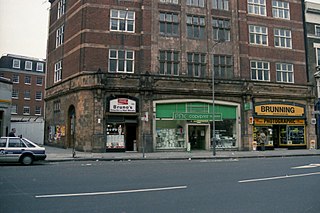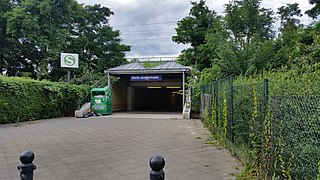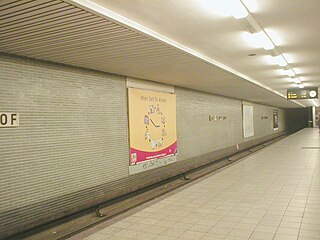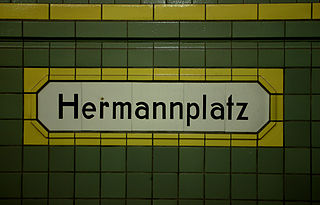
British Museum was a station on the London Underground, located in Holborn, central London. It was latterly served by the Central line and took its name from the nearby British Museum in Great Russell Street.

Stockwell is a London Underground station in Stockwell in the London Borough of Lambeth. It is located on the Northern line between Oval and Clapham North stations, and on the Victoria line between Brixton and Vauxhall stations. It is in Travelcard Zone 2.

The Berlin U-Bahn is a rapid transit system in Berlin, the capital and largest city of Germany, and a major part of the city's public transport system. Together with the S-Bahn, a network of suburban train lines, and a tram network that operates mostly in the eastern parts of the city, it serves as the main means of transport in the capital.
U8 is a line on the Berlin U-Bahn. It has 24 stations and is 18.1 km (11.2 mi) long. The U8 is one of three north–south Berlin U-Bahn lines, and runs from Wittenau to Neukölln via Gesundbrunnen. The original proposal was for a suspended monorail like the Wuppertal Schwebebahn.

Berlin Jungfernheide is a railway station located at Charlottenburg-Nord, in the Charlottenburg-Wilmersdorf district of Berlin, served by the S-Bahn lines and , the U-Bahn line and Regional-Express trains of the Deutsche Bahn. Its name literally translates into "maidens' heathland"; it was named after the Jungfernheide, a former large forest in the proximity of this station.

St James railway station is a heritage-listed underground commuter rail station that is located on the City Circle, at the northern end of Hyde Park in the Sydney central business district of New South Wales, Australia. It is served by Sydney Trains T2 Inner West & Leppington, T3 Bankstown & T8 Airport & South line services. It is named after the nearby St James' Church and provides a direct link to the Sydney Airport international and domestic railway stations. It was added to the New South Wales State Heritage Register on 2 April 1999.

A ghost station is a disused train station through which revenue-service passenger trains pass but at which they do not stop. The term is also sometimes used for any unused underground station or any unused station, whether or not trains pass through them. In Germany, a station that has been built in the course of constructing something else as a so-called "Bauvorleistung" is referred to as a "ghost station", despite the different purpose and origin of the terms. Some English-language publications also refer to "pre-built" stations or parts thereof that have yet to see service as "ghost stations".

Klosterstraße is a Berlin U-Bahn station located on the in the centrally located Mitte district. The eponymous street is named after the Graues Kloster, a medieval Franciscan abbey, which later housed the Berlinisches Gymnasium zum Grauen Kloster.

Märkisches Museum is a Berlin U-Bahn station located on the in the Mitte district. Since 1935 it has been named after the nearby Märkisches Museum, the municipal museum of the history of Berlin and the Mark Brandenburg.

Berlin Innsbrucker Platz is a railway station in the Schöneberg district of Berlin and located on the square of the same name. It is served by the Ringbahn lines , and of the Berlin S-Bahn. It is also the terminus of the U-Bahn line .

Weberwiese is a Berlin U-Bahn station located on the line, which currently runs from Berlin Central Station to Hönow. The station is located under Karl-Marx-Allee directly east of Straße der Pariser Kommune. Although the next station on the line is called Frankfurter Tor, the historical city gate Frankfurter Tor actually stood at the location of the Weberwiese station. Several of the stations on this line have been recently redeveloped and are now colour-coded. In 2003, Weberwiese station was renovated and now has a very different appearance, with yellow tiles in contrast to its former white ones.

Berlin-Lichtenberg is a railway station in Berlin, Germany. It is located on the Eastern Railway, Wriezen Railway and Berlin Frankfurter Allee–Berlin-Rummelsburg railway lines in the Lichtenberg district. The station is also part of the Berlin S-Bahn and U-Bahn network.

Seestraße is a station in the Wedding district of Berlin which serves the and is operated by the BVG. It lies at the busy intersection of Müllerstraße and Seestraße, which are two of Wedding's principal shopping streets and thoroughfares.

Tempelhof is a railway station in the district of Berlin with the same name. It is served by the S-Bahn lines , , and and the U-Bahn line . The S-Bahn station is on an embankment at the junction of Tempelhofer Damm and Bundesautobahn 100, about 1 km south of the entrance to the former Tempelhof Airport. The U-Bahn station, officially called Tempelhof (Südring), is under Tempelhofer Damm immediately south of the S-Bahn station.

Alt-Tempelhof is a Berlin U-Bahn station on the . It is located under Tempelhofer Damm in the centre of the former village of Tempelhof, now a Berlin district within the borough of Tempelhof-Schöneberg. The station opened on 28 February 1966.

Hermannplatz is a station in the Neukölln district of Berlin which serves as an interchange between the lines and . Operated by the BVG, it is one of the busiest stations on the Berlin U-Bahn system.

Leinestraße is a Berlin U-Bahn station located on the line.

Berlin Hermannstraße is a railway station in the Neukölln district of Berlin. It is served by the S-Bahn lines , , , and and the U-Bahn line , of which it is the southern terminus. It was formerly also possible to transfer there to the Neukölln-Mittenwalde railway line, which is now only used for goods traffic.

Turmstraße is a Berlin U-Bahn station located on the line. The station is located in fare zone A. It was opened on 28 August 1961, and designed by B. Grimmek.

The Berlin U-Bahn originated in 1880 with Werner Siemens' idea to build an urban railway in Berlin. During the nine years after the German Empire was founded, the city's population grew by over one-third and traffic problems increased. In 1896, Siemens & Halske began to construct the first stretch of overhead railway. On 1 April 1897, the company began construction of an electric underground railway. The Berliner Verkehrs Aktiengesellschaft (BVG) was formed in 1928, and took over further construction and operation of the network. In 1938, the company was renamed Berlin Transport Company; the original acronym, however, remained. Since 1994, the BVG has been a public company.

![]() line. Peter Behrens constructed this unusual subway station in Berlin in 1928. It was closed briefly in 1945, and between 1961 and 1990 it was the last station in West Berlin, after which the train passed through communist East Berlin until Gesundbrunnen.
line. Peter Behrens constructed this unusual subway station in Berlin in 1928. It was closed briefly in 1945, and between 1961 and 1990 it was the last station in West Berlin, after which the train passed through communist East Berlin until Gesundbrunnen.

















